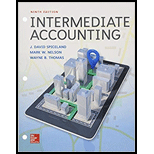
Concept explainers
Judgment Case 13–9
Loss contingency and full disclosure
• LO13–5, LO13–6
In the March 2019 meeting of Valleck Corporation’s board of directors, a question arose as to the way a possible obligation should be disclosed in the forthcoming financial statements for the year ended December 31. A veteran board member brought to the meeting a draft of a disclosure note that had been prepared by the controller’s office for inclusion in the annual report. Here is the note:
On May 9, 2018, the United States Environmental Protection Agency (EPA) issued a Notice of Violation (NOV) to Valleck alleging violations of the Clean Air Act. Subsequently, in June 2018, the EPA commenced a civil action with respect to the foregoing violation seeking civil penalties of approximately $853,000. The EPA alleges that Valleck exceeded applicable volatile organic substance emission limits. The Company estimates that the cost to achieve compliance will be $190,000; in addition the Company expects to settle the EPA lawsuit for a civil penalty of $205,000 which will be paid in 2019.
“Where did we get the $205,000 figure?” he asked. On being informed that this is the amount negotiated last month by company attorneys with the EPA, the director inquires, “Aren’t we supposed to report a liability for that in addition to the note?”
Required:
Explain whether Valleck should report a liability in addition to the note. Why or why not? For full disclosure, should anything be added to the disclosure note itself?
Want to see the full answer?
Check out a sample textbook solution
Chapter 13 Solutions
INTERMEDIATE ACCOUNTING(LL)-W/CONNECT
- Portland Waxworks budgeted production of 46,000 wax lanterns for the year. Each lantern requires dipping. Assume that 12 minutes are required to dip each lantern. If dipping labor costs $14.50 per hour, determine the direct labor cost budget for the year.arrow_forwardI need help finding the accurate solution to this general accounting problem with valid methods.arrow_forwardNonearrow_forward
- Please provide the correct answer to this general accounting problem using accurate calculations.arrow_forwardI need help with question is correct answer and accountingarrow_forwardSatish's vacation home was destroyed by a hurricane. She had purchased the home 30 months ago for $925,000. She received $1,175,000 from her insurance company to replace the home. If she fails to rebuild the home or acquire a replacement home in the required time, how much gain must she recognize on this conversion? A. $250,000 B. $180,000 C. $125,000 D. $0 E. None of the abovearrow_forward
- Can you solve this general accounting problem using accurate calculation methods?arrow_forwardSteelForm Ltd. produces steel fixtures that require 3 meters of material at $1.50 per meter and 0.4 direct labor hours at $20.00 per hour. Overhead is applied at the rate of $10 per direct labor hour. What is the total standard cost for one unit of product that would appear on a standard cost card?Helparrow_forwardCan you explain this general accounting question using accurate calculation methods?arrow_forward
 Accounting (Text Only)AccountingISBN:9781285743615Author:Carl Warren, James M. Reeve, Jonathan DuchacPublisher:Cengage Learning
Accounting (Text Only)AccountingISBN:9781285743615Author:Carl Warren, James M. Reeve, Jonathan DuchacPublisher:Cengage Learning Cornerstones of Financial AccountingAccountingISBN:9781337690881Author:Jay Rich, Jeff JonesPublisher:Cengage Learning
Cornerstones of Financial AccountingAccountingISBN:9781337690881Author:Jay Rich, Jeff JonesPublisher:Cengage Learning Financial & Managerial AccountingAccountingISBN:9781285866307Author:Carl Warren, James M. Reeve, Jonathan DuchacPublisher:Cengage Learning
Financial & Managerial AccountingAccountingISBN:9781285866307Author:Carl Warren, James M. Reeve, Jonathan DuchacPublisher:Cengage Learning Survey of Accounting (Accounting I)AccountingISBN:9781305961883Author:Carl WarrenPublisher:Cengage Learning
Survey of Accounting (Accounting I)AccountingISBN:9781305961883Author:Carl WarrenPublisher:Cengage Learning Financial & Managerial AccountingAccountingISBN:9781337119207Author:Carl Warren, James M. Reeve, Jonathan DuchacPublisher:Cengage Learning
Financial & Managerial AccountingAccountingISBN:9781337119207Author:Carl Warren, James M. Reeve, Jonathan DuchacPublisher:Cengage Learning AccountingAccountingISBN:9781337272094Author:WARREN, Carl S., Reeve, James M., Duchac, Jonathan E.Publisher:Cengage Learning,
AccountingAccountingISBN:9781337272094Author:WARREN, Carl S., Reeve, James M., Duchac, Jonathan E.Publisher:Cengage Learning,





